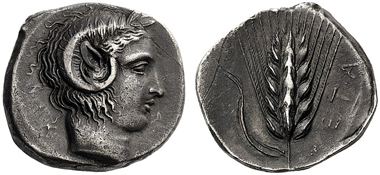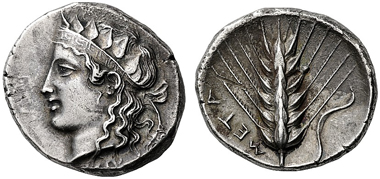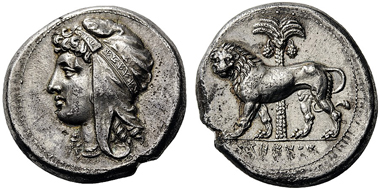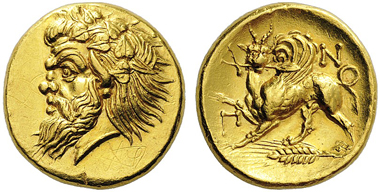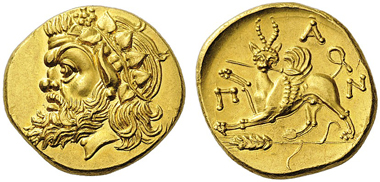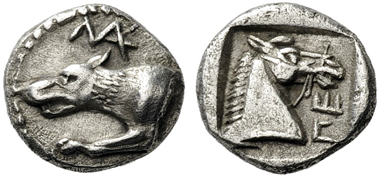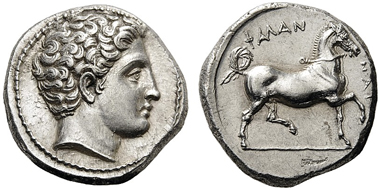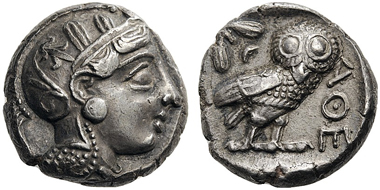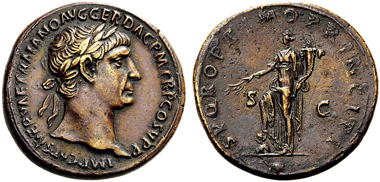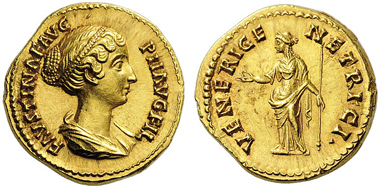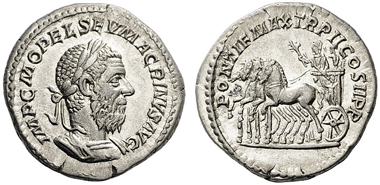21-10-2013 – 01-01-1970
Auction 8
Ancient coins at Nomos
Once again Nomos has an attractive selection of coins, ranging from some of the earliest electrum pieces struck in Asia Minor to gold of the Middle Byzantine period. Not only are there many Greek and Roman rarities, including some that are unique, one of the highlights of this sale is a small collection of pedigreed pieces bought primarily from the late 1960s through the mid 1990s. The collector was interested in beauty and, working with the late Frank Sternberg, managed to acquire a number of quite lovely pieces from the great sales of the past: the wonderful Eukleidas tetradrachm from Kunstfreund and Hunt is only one of them (52). There are coins in this sale of all sizes, from chalkoi and hemiobols to oktadrachms and dekadrachms, and in all metals; and with estimates from 150 to 100,000 Swiss Francs.
As usual there are a number of surprises in this sale: unusual rarities like the best and most complete known ‘wolf’ obol of Perrhaiboi, or two exceptional denarii of the third century, one certainly unique; but anyone looking through this catalogue will find others!
Highlights
This coin forms part of a very unusual issue: not only is the appearance of Apollo Karneios a surprise, but a goodly number of the known examples are actually ancient forgeries (i.e, Noe 334, 338 ff. – most are very much underweight, usually plated, and are of distinctly poor style). In some ways this implies that these coins were issued for a special reason; given that Karneios was closely connected with Lakedaimon, could it be that a small issue was produced to honor an ephemeral relationship between Metapontum and Sparta? In any case, this is one of the nicest genuine examples of the type known.
The head of the young Dionysos here is of great elegance and freshness, lacking any sign of the drunkenness that so often accompanies the god: without the diadem that so clearly identifies him he might well be Apollo. This piece is one of the finest examples of this type known.
One of the great coins of the late 5th century BC, this is a prime example of the kind of spectacular workmanship that the Sicilian cities used to enable their coins to advertise their wealth and power. It has been suggested that the head on this coin is not that of Athena, but of Arethusa wearing Athena’s helmet, in celebration of the Syracusan triumph over the Athenians. However, would Arethusa not only be wearing Athena’s helmet but her necklace as well? This seems really unlikely. In fact, Athena was honored at Syracuse: a sanctuary was erected to her on the Ortygia to commemorate the Syracusan triumph over the Carthaginians in 480 BC. At around the time this coin was issued Sicily was facing yet another Carthaginian invasion – which resulted in the destruction of Akragas – so a coinage honoring Athena would be quite appropriate. As for the date of this coin, it is surely late 5th century, but whether it was struck during the last years of the Democracy, or shortly after Dionysos I (405-367 BC) seized power is uncertain.
This is probably the most beautiful of all Carthaginian silver coins and must have been designed and engraved by a Greek artist. In the past this head was identified as that of Dido, the legendary queen of Carthage but it seems more like to be the city’s patron goddess Tanit as viewed by a Greek artist. She seems to be shown with hair in curls that mark her as being ‘foreign’, not at all like the female heads that are shown on other Siculo-Punic issues. Her headdress is also very unusual, as is the palmette-ornamented ribbon that encircles it. It is more than likely that this splendid Tanit head was thought to be simply too exotic for general use and, thus, was replaced by the more standard, and more familiar, Tanit heads based on Euainetos’ conception of Arethusa.
The only other known example of a Pantikapaion stater struck from this pair of dies appeared in Leu 81 as lot 124. That coin, part of the collection of R. Abecassis, had been acquired from Spink’s in the very late 1960s and was reliably said to be from the Empedocles collection (many Empedocles coins were bought by Cahn in the late 1940s and early 1950s, and then sold further). The satyr head on the obverse is particularly powerful and has very wild hair, rather similar to that found on the earliest staters of Pantikapaion, as Gulbenkian 581 and Prinkipo 166. A marginally more mannered head, though probably by the same engraver, can be seen on Gulbenkian 586 and KF 188.
The coinage of Pantikapaion, the wealthy trading and agricultural city on the Crimea, is famous for its gold issues. They bear the head of a satyr, the city’s badge, combined with a griffin, the mythical guardian of the gold that was found far to the east. This is a superb example.
This is quite an extraordinary coin! The types have been known since the Photiades Pasha sale in 1890, but both previously published examples were insufficiently preserved to allow the obverse monogram to be read correctly. In any event, what the obverse monogram signifies is a mystery: magistrates’ names or monograms very rarely appeared on Thessalian coins this early, and being in such a prominent position on the coin would be exceptional. The possibility that it refers to a political grouping or a prominent leader is certainly conceivable. One suggestion is that it refers to the Macedonians who were on Perrhaiboia’s northern border, and implies that there was some form of alliance between the two states.
This is one of the finest known examples of the type and is better than any of the pieces from the BCD collection. As for the identification of the male head as the hero Peloros, it has also been suggested that he could be Apollo or Ares, though the lack of any wreath or taenia makes that unlikely. The similarity between this head and that of Apollo on the gold staters of Philip suggests that the issues of Phalanna were influenced by them.
This is quite an outstanding early profile eye tetradrachm: the head has an almost archaistic character, as if the engraver was deliberately harking back to the style of the late 6th and earliest 5th centuries. The vast majority of Athenian tetradrachms of the 4th century come from the great re-coinage, are struck on folded flans and are usually misshapen. Coins like the present one, struck on a fresh flan earlier in the century, are much rarer, primarily because all those issues were called in and restruck in 353.
Struck from the same obverse die as the last (165), but from a different reverse die, this coin helps to show quite how small was the issue in which these coins were struck. If we are only dealing with single obverse die paired with two reverses, the total number of coins struck was probably not more than five talents, thus helping to explain why so few of them survived.
This coin must have been issued just prior to Macrinus’ downfall and would have then been withdrawn, Aurei, sestertii, dupondii and asses with this type have long been known, but this is the first denarius to appear. This is not all that surprising: many Roman issues were originally produced in all metals but through the accidents of survival, only certain denominations are known today.
You can find the complete catalogue online.
The catalogue has been shipped to active customers. If you would like to order an example, please contact us. Price: 45 CHF.
You find the contact details online.
The coins can be viewed mondays through fridays from 10 a.m. until 5 p.m., and at other times by appointment. Please call first +41 (0)44 250 51 80. Nomos AG is looking forward to welcome you at their office in the historic old town of Zürich.
In order to place your bids you can either contact us or bid live online. Remember, you must register, prior to placing any bids.
If you are interested in consigning material to Nomos, or would like to explore a direct sale, or merely need numismatic advice, please contact Nomos AG.




